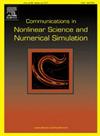基于水平集方法的两个最小p-拉普拉斯特征值拓扑优化
IF 3.4
2区 数学
Q1 MATHEMATICS, APPLIED
Communications in Nonlinear Science and Numerical Simulation
Pub Date : 2025-04-17
DOI:10.1016/j.cnsns.2025.108854
引用次数: 0
摘要
本文研究几何体积或周长约束下两个最小Dirichlet p- laplace特征值的优化问题。提出了一种带有形状灵敏度分析的松弛拓扑优化模型。采用水平集法和有限元离散法对模型问题进行了数值求解。利用拟牛顿方法有效地求解了p-拉普拉斯特征值,即使对于p的极值也能得到准确的结果。数值结果表明,对于第一个特征值,在两种约束下的最优形状是二维的圆盘和三维的球,与p无关。对于第二个特征值,在体积约束下,优化器有两个相同的圆盘或球,与p无关。随着p值的增加,优化后的形状在周长约束下由椭球形向平面形演化。本文章由计算机程序翻译,如有差异,请以英文原文为准。
Topology optimization of the two smallest p-Laplacian eigenvalues by a level set method
This paper considers optimization of the two smallest Dirichlet -Laplacian eigenvalues subject to geometric volume or perimeter constraint. A relaxed topology optimization model with shape sensitivity analysis is presented. A level set method and finite element discretization are employed to numerically solving the model problems. The -Laplacian eigenvalue is efficiently solved using quasi-Newton method, which achieves accurate results even for extreme values of . Numerical results are provided to indicate that for the first eigenvalue, the optimal shapes are disks in 2D and balls in 3D under both constraints, independent of . For the second eigenvalue, optimizers have two identical disks or balls independent of under volume constraint, while optimized shapes evolve from ellipsoidal to flatter configurations under perimeter constraint as increases.
求助全文
通过发布文献求助,成功后即可免费获取论文全文。
去求助
来源期刊

Communications in Nonlinear Science and Numerical Simulation
MATHEMATICS, APPLIED-MATHEMATICS, INTERDISCIPLINARY APPLICATIONS
CiteScore
6.80
自引率
7.70%
发文量
378
审稿时长
78 days
期刊介绍:
The journal publishes original research findings on experimental observation, mathematical modeling, theoretical analysis and numerical simulation, for more accurate description, better prediction or novel application, of nonlinear phenomena in science and engineering. It offers a venue for researchers to make rapid exchange of ideas and techniques in nonlinear science and complexity.
The submission of manuscripts with cross-disciplinary approaches in nonlinear science and complexity is particularly encouraged.
Topics of interest:
Nonlinear differential or delay equations, Lie group analysis and asymptotic methods, Discontinuous systems, Fractals, Fractional calculus and dynamics, Nonlinear effects in quantum mechanics, Nonlinear stochastic processes, Experimental nonlinear science, Time-series and signal analysis, Computational methods and simulations in nonlinear science and engineering, Control of dynamical systems, Synchronization, Lyapunov analysis, High-dimensional chaos and turbulence, Chaos in Hamiltonian systems, Integrable systems and solitons, Collective behavior in many-body systems, Biological physics and networks, Nonlinear mechanical systems, Complex systems and complexity.
No length limitation for contributions is set, but only concisely written manuscripts are published. Brief papers are published on the basis of Rapid Communications. Discussions of previously published papers are welcome.
 求助内容:
求助内容: 应助结果提醒方式:
应助结果提醒方式:


